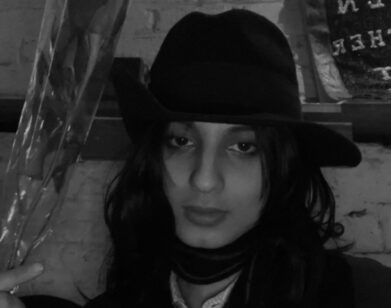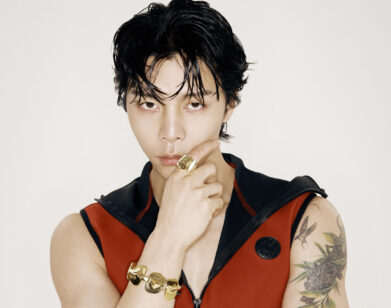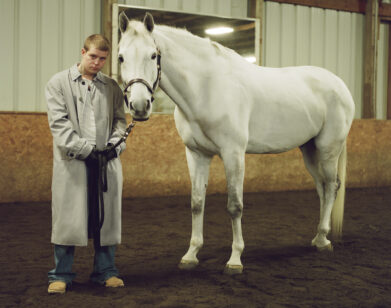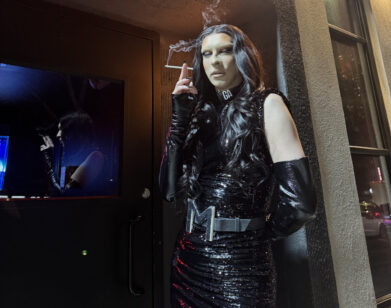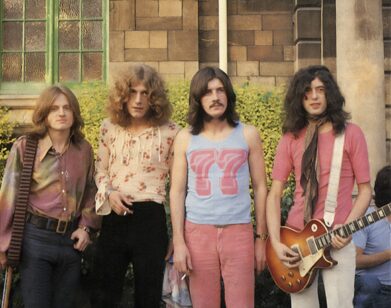Exclusive Song Premiere and Interview: ‘Wake Up in the Void,’ Dinowalrus
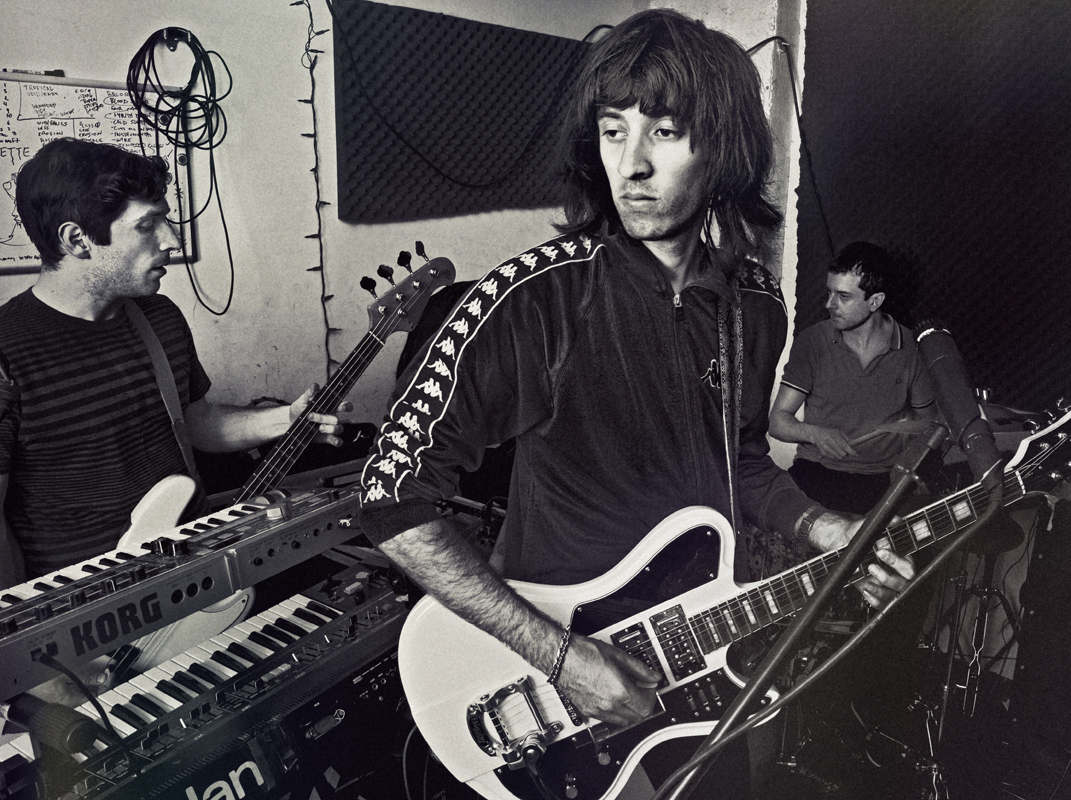
ABOVE: DINOWALRUS. PHOTO BY ANDY RYAN
When Williamsburg’s Dinowalrus released their first album, %, five years ago, they might have been described using the kind of multi-hyphenation (experimental-post-punk-noise-psych) associated with late-2000s Bushwick (show on a rooftop, shirtless dude in the crowd twirling a grimy paint brush above his head).
The band’s sound matured, and front man Peter Feigenbaum overhauled the lineup, adding bassist-keyboardist Liam Andrew and drummer Max Tucker. Sublimating the psychotic propulsion of %, their second offering, Best Behavior, was a poppy, electro update on their psychedelic bedrock, with forays into the Madchester sounds of late-’80s/early-’90s northern England. But under the layers of Stone Roses-esque guitarpeggios and bongo-cool dance beats à la Happy Mondays, Dinowalrus was striving toward something more singular. Their latest album, Complexion (Personal Projects), which came out this past June, melds Best Behavior‘s revivalist exuberance with the icy sheen of early Simple Minds and the shining plastic gospel of Primal Scream, circa 1991.
Feigenbaum, a Yale graduate working on a master’s in architecture at Columbia, is also a sculptor whose works have shown at various galleries around town and The Museum of Arts and Design and ISE Cultural Foundation. We recently caught up with him at a bar in Greenpoint. We’re also pleased to share the newest single from Complexion, “Wake Up in the Void,” as our Track of the Week.

DAVID JACK DANIELS: So, Pete, read any good rock bios lately?
PETER FEIGENBAUM: I’ve taken a break from rock-bio reading for a bit. They all have the same arc: We had fun, everything was rad, then the egos and drugs got in the way, then we recovered, then we rode off into the sunset in a Camaro. [Daniels laughs] After having it on my to-do list for eight years, I finally delved into this urban design/theory book The Image of The City by Kevin Lynch, which explores spatial cognition and memory and how latent characteristics of the built landscape help or hinder our ability to navigate around cities. I think the last rock bio I read was Hammer of the Gods, which was actually less exciting than I thought was going to be. But I will say I was really into Peter Hook’s How Not to Run a Club. He’s a colorful writer by any standard, and you don’t necessarily have to be a New Order or Manchester music fan to appreciate his crazy stories.
DANIELS: That reminds me of Andre Agassi’s autobiography. I’m not really into tennis, but his writing is so good, I feel like anyone could relate.
FEIGENBAUM: I heard Agassi lost the French Open because he was afraid his wig would fall off and didn’t want to move around too much! [Daniels laughs]
DANIELS: So you grew up in Boston?
FEIGENBAUM: That’s right—in a suburb. No one in my town was into punk rock, and I was too lazy to go to house shows in Allston, so I can’t say my time there had much of a direct impact on me. Culturally, it’s a very English/Irish part of America, so that’s maybe why I appreciate sounds from the Northern UK so much.
DANIELS: Speaking of which, what are your thoughts on Dinowalrus being pegged as a Madchester revivalist band—in much the same way Australia’s Jagwar Ma has been recently?
FEIGENBAUM: Madchester sounds are definitely at the sweet spot of our songwriting, but we branch out quite a bit. I love Jagwar Ma, but we try to present things more in a rock-‘n’-roll format. But we aren’t necessarily re-writing [the Happy Monday’s] “Loose Fit” 10 times over. Interestingly, even within the Madchester canon, both the Stone Roses debut album and [Primal Scream’s] Screamadelica exhibit a pretty wide stylistic range. I mean, [the Stone Roses’] “Elizabeth My Dear” is like a pastoral English Folk song, and then they swung the complete opposite way towards the Sly Stone-inspired “Fool’s Gold.” If you want to make an album where people actually remember the individual songs in a distinct way, it’s definitely better to err on the side of stylistic diversity—all the best bands from The Stones to Nirvana always made a point of this.
DANIELS: I think it’s interesting how Dinowalrus started off primarily as a psychedelic noise band, but this latest record moves into different territory.
FEIGENBAUM: I think the shift in tones had to do with changing personal tastes—moving from Liars to Primal Scream to The Chameleons! We had a strong inclination to be as danceable and ecstatic as possible on the second album, while still keeping things a bit long-form. On Complexion, we were interested in being expressive but also relatively concise. Complexion is kind of like the dark reality that emerges after the party ends.
DANIELS: You’re a big Primal Scream fan.
FEIGENBAUM: Yeah.
DANIELS: That shows on the new album, but maybe not as overtly as, like, on Screamadelica—this anthemic gospel kind of thing.
FEIGENBAUM: Yeah, we tried to get as gospel as possible, maybe not full-on, though … Primal Scream are more sample-y, more electronic, so the gospel gets detached. I know for the album after Screamadelica, they went to Ardent Studios in Memphis and brought in the Muscle Shoals rhythm section and worked with Jim Dickinson to make, like, a bona fide Memphis rock-‘n’-roll record, Give Up But Don’t Give Out, which everybody hated. I really like that record, though. But that’s the brilliance of Screamadelica, it’s shape-shifting; every song contradicts but also builds upon the previous one. It’s kind of like a first-person trip through a night out in the acid-house era of Manchester in 1990.
DANIELS: So maybe Dinowalrus is another link in the chain, of reinterpreting something that was already reinterpreted. I mean, that’s what it’s all about, right?
FEIGENBAUM: Yeah, I mean, I’d like to think we dig a little deeper for our influences than your typical band around town. That’s what sets us apart. It’s not like the same old, like, Pavement, Dinosaur Jr., Weezer, or whatever.
DANIELS: This album also has more of a goth feel than your last two.What albums would you say influenced the writing on Complexion
FEIGENBAUM: Probably Echo and the Bunnymen … The first two Cult records, Dreamtime and Love; and Simple Minds, too, their record New Gold Dream.
DANIELS: What have you been listening to these days?
FEIGENBAUM: For whatever reason, I’m listening to more introspective music. I mean, I haven’t listened to any Mötley Crüe in months [Feigenbaum also records under the nom de plume Peter Fudge for his Sunset Strip glam project Lovewrecker], which is surprising, because usually I’ll listen to hard rock, party metal, not all the time, but, like, at work. I haven’t listened to any Judas Priest in a while, either. I’ve been listening to The Horrors quite a bit lately … Also, the first Oasis record. Ever since I saw the Creation Records documentary [Upside Down: The Creation Records Story, 2010]. It’s a chronology of northern English music, Glasgow and Manchester. I don’t know, maybe that’s embarrassing for me to say, “I’m really into Oasis,” when I could be into, like, some comp from Sublime Frequencies, uh, you know, or obscure funk from Burkina Faso…. [both laugh] I always thought Oasis was really annoying. Like, Liam Gallagher’s voice was too nasal and cutesy. I was into stuff that was a little more agro when I was a kid, but it’s nice to revisit these things I heard on the radio back then but didn’t really get the first time around.
DANIELS: How do your other avenues of creativity, sculpture and architecture, inform or influence your music?
FEIGENBAUM: Oh, I’d say they’re all related in terms of process. I think about music very visually and spatially. Since I’ve started using Ableton extensively to make music, my approach to production and songwriting has become quite modular and architectural in a sense. Production is a beautiful synthesis of the aesthetic and the functional. A kick drum that doesn’t put out the right frequency or power the low-end groove is kind of like a building with windows in the wrong place. Also, I think a lot about bringing the aesthetics of the past into the future in all of my endeavors—seems to be a recurring theme.
DANIELS: What do you ultimately want for Dinowalrus? Do you see arriving at a spot where you’ll be satisfied?
FEIGENBAUM: Complete creative self-actualization with the side effect of world domination. Creatively, things have been satisfying from day one, so it’s no big deal if we have to put out 10 albums to finally capture the music-listening public’s hearts and minds in a major way … we just gotta keep on truckin’, like, uh, Anton Newcombe. I take pride in the fact that I’m in it for the long haul.
DANIELS: So one more question before we go. What’s your all-time get-down record before going out at night?
FEIGENBAUM: The “G” side of G’N’R Lies!
DINOWALRUS PLAYS THE STUDIO AT WEBSTER HALL ON SATURDAY, AUGUST 9. FOR MORE ON THE BAND, PLEASE VISIT ITS WEBSITE.

